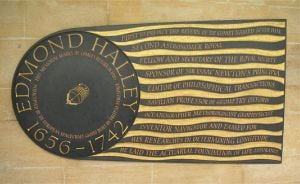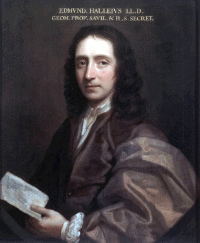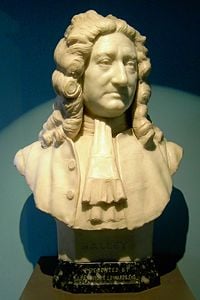Encyclopedia, Difference between revisions of "Edmond Halley" - New World
Peter Duveen (talk | contribs) |
Peter Duveen (talk | contribs) |
||
| Line 12: | Line 12: | ||
On leaving [[University of Oxford|Oxford]], in 1676, he visited the south Atlantic island of [[St. Helena]], an island south of the equator in the middle of the Atlantic Ocean, with the intention of studying stars from the Southern Hemisphere. He returned to England in November 1678. In the following year he published ''Catalogus Stellarum Australium'' which included details of 341 southern stars. He was awarded his M.A. degree at Oxford by order of the king and was elected a fellow of the [[Royal Society]]. The Royal Astronomer at the time, Flamsteed, dubbed Halley "the Southern Tycho" for his accomplishment. | On leaving [[University of Oxford|Oxford]], in 1676, he visited the south Atlantic island of [[St. Helena]], an island south of the equator in the middle of the Atlantic Ocean, with the intention of studying stars from the Southern Hemisphere. He returned to England in November 1678. In the following year he published ''Catalogus Stellarum Australium'' which included details of 341 southern stars. He was awarded his M.A. degree at Oxford by order of the king and was elected a fellow of the [[Royal Society]]. The Royal Astronomer at the time, Flamsteed, dubbed Halley "the Southern Tycho" for his accomplishment. | ||
| − | In 1680, he toured continental Europe with Robert Nelson, and made the acquaintance of many scientists including the Italian astronomer Casini. | + | In 1680, he toured continental Europe with Robert Nelson, and made the acquaintance of many scientists including the Italian astronomer Casini. |
Halley married Mary Tooke in 1682 and settled in [[Islington]], where he established an observatory for his own researches. He spent most of his time on lunar observations for the purposes of developing a method to determine longitude at sea, but was also interested in the problems of [[gravity]]. One problem that attracted his attention was the proof of [[Kepler's laws of planetary motion]]. He believed that the planetary motions suggested that the attractive force between the sun and the planets diminshes in proportion to the square of their distances, but could not demonstrate it rigorously. After approaching several astronomers of note, he went to [[University of Cambridge|Cambridge]] to discuss this with [[Isaac Newton]], only to find that Newton had solved the problem but published nothing. Halley convinced him to write the ''[[Principia Mathematica Philosophiae Naturalis]]'' (1687), which was published at Halley's expense. | Halley married Mary Tooke in 1682 and settled in [[Islington]], where he established an observatory for his own researches. He spent most of his time on lunar observations for the purposes of developing a method to determine longitude at sea, but was also interested in the problems of [[gravity]]. One problem that attracted his attention was the proof of [[Kepler's laws of planetary motion]]. He believed that the planetary motions suggested that the attractive force between the sun and the planets diminshes in proportion to the square of their distances, but could not demonstrate it rigorously. After approaching several astronomers of note, he went to [[University of Cambridge|Cambridge]] to discuss this with [[Isaac Newton]], only to find that Newton had solved the problem but published nothing. Halley convinced him to write the ''[[Principia Mathematica Philosophiae Naturalis]]'' (1687), which was published at Halley's expense. | ||
| Line 22: | Line 22: | ||
In 1693 he published an article on life annuities, which featured an analysis of age-at-death taken from the records of [[Wrocław|Breslau]], a Polish-German town known for keeping meticulous records. This allowed the British government to sell life annuities at an appropriate price based on the age of the purchaser. Halley's work strongly influenced the development of [[actuarial science]]. The construction of the life-table for Breslau, which followed more primitive work by [[John Graunt]], is now seen as a major event in the history of [[demography]]. | In 1693 he published an article on life annuities, which featured an analysis of age-at-death taken from the records of [[Wrocław|Breslau]], a Polish-German town known for keeping meticulous records. This allowed the British government to sell life annuities at an appropriate price based on the age of the purchaser. Halley's work strongly influenced the development of [[actuarial science]]. The construction of the life-table for Breslau, which followed more primitive work by [[John Graunt]], is now seen as a major event in the history of [[demography]]. | ||
| − | In 1698 he received a commission as captain of HMS ''Paramore'' to make extensive observations on the conditions of terrestrial [[magnetism]]. | + | When the British decided to resume silver coinage, Halley was appointed comptroller of the mint at Chester, one of five in the country, a position he held for two years. |
| + | |||
| + | In 1698 he received a commission as captain of HMS ''Paramore Pink'' to make extensive observations on the conditions of terrestrial [[magnetism]]. A mutinous crew necessitated his return to England, but he soon set out again. His journeys over the Atlantic spanned a period of two years, and extended from 52 degrees north to 52 degrees south. The results were published in a ''General Chart of the Variation of the Compass'' (1701). This was the first such chart to be published and represented the first appearance of [[Isogon (geomagnetism)|isogonic]], or Halleyan, lines that link points on the globe where the deviation of a compass from magnetic north are the same. | ||
| + | |||
| + | The next couple of years he spent observing tides and maping the English channel at the request of the king, and he performed a similar task for the empress of Germany. | ||
In November 1703 he was appointed Savilian professor of [[geometry]] at Oxford University, and received an honorary degree of doctor of laws in 1710. In 1705, applying [[historical astronomy]] methods, he published ''Synopsis Astronomia Cometicae'', which stated his belief that the comet sightings of 1456, 1531, 1607, and 1682 related to the same comet, which he predicted would return in 1758. When it did it became generally known as [[Halley's Comet]]. | In November 1703 he was appointed Savilian professor of [[geometry]] at Oxford University, and received an honorary degree of doctor of laws in 1710. In 1705, applying [[historical astronomy]] methods, he published ''Synopsis Astronomia Cometicae'', which stated his belief that the comet sightings of 1456, 1531, 1607, and 1682 related to the same comet, which he predicted would return in 1758. When it did it became generally known as [[Halley's Comet]]. | ||
| + | |||
| + | He was also engaged at this time in the translation of the works of the famous Greek geometer Appolonius from Arabic. | ||
In 1716 Halley suggested a high-precision measurement of the distance between the Earth and the Sun by timing the [[transit of Venus]]. In doing so he was following the method described by [[James Gregory (astronomer and mathematician)|James Gregory]] in ''[[Optica Promota]]'' (in which the design of the Gregorian telescope is also described). It is reasonable to assume Halley possessed and had read this book given that the Gregorian design was the principal telescope design used in astronomy in Halley's day. It is not to Halley's credit that he failed to acknowledge Gregory's priority in this matter. In 1718 he discovered the [[proper motion]] of the "fixed" stars by comparing his [[astrometry|astrometric]] measurements with those of the Greeks. | In 1716 Halley suggested a high-precision measurement of the distance between the Earth and the Sun by timing the [[transit of Venus]]. In doing so he was following the method described by [[James Gregory (astronomer and mathematician)|James Gregory]] in ''[[Optica Promota]]'' (in which the design of the Gregorian telescope is also described). It is reasonable to assume Halley possessed and had read this book given that the Gregorian design was the principal telescope design used in astronomy in Halley's day. It is not to Halley's credit that he failed to acknowledge Gregory's priority in this matter. In 1718 he discovered the [[proper motion]] of the "fixed" stars by comparing his [[astrometry|astrometric]] measurements with those of the Greeks. | ||
Revision as of 09:29, 13 June 2007
Edmond Halley FRS (sometimes "Edmund," November 8, 1656 – January 14, 1742) was an English astronomer, geophysicist, mathematician, meteorologist, and physicist.
Biography and career
Halley was born at Haggerston, London, the son of a wealthy soapboiler. As a child, he was very interested in mathematics. He studied at St Paul's School, and then, in 1673, after having already achieved competence in plane and spherical geometry, navigation and astronomy, entered The Queen's College, Oxford. In 1875, while still an undergraduate he published an important paper lending mathematical support to Johannes Kepler's laws of planetary motion. A year later, observations of sunspots allowed him to calculate the rate at which the sun rotates about its axis.
On leaving Oxford, in 1676, he visited the south Atlantic island of St. Helena, an island south of the equator in the middle of the Atlantic Ocean, with the intention of studying stars from the Southern Hemisphere. He returned to England in November 1678. In the following year he published Catalogus Stellarum Australium which included details of 341 southern stars. He was awarded his M.A. degree at Oxford by order of the king and was elected a fellow of the Royal Society. The Royal Astronomer at the time, Flamsteed, dubbed Halley "the Southern Tycho" for his accomplishment.
In 1680, he toured continental Europe with Robert Nelson, and made the acquaintance of many scientists including the Italian astronomer Casini.
Halley married Mary Tooke in 1682 and settled in Islington, where he established an observatory for his own researches. He spent most of his time on lunar observations for the purposes of developing a method to determine longitude at sea, but was also interested in the problems of gravity. One problem that attracted his attention was the proof of Kepler's laws of planetary motion. He believed that the planetary motions suggested that the attractive force between the sun and the planets diminshes in proportion to the square of their distances, but could not demonstrate it rigorously. After approaching several astronomers of note, he went to Cambridge to discuss this with Isaac Newton, only to find that Newton had solved the problem but published nothing. Halley convinced him to write the Principia Mathematica Philosophiae Naturalis (1687), which was published at Halley's expense.
In 1690, Halley built a diving bell, in which device the atmosphere was replenished by way of weighted barrels of air sent down from the surface. In a demonstration, Halley and five companions dived to 60 feet in the River Thames, and remained there for over one and a half hours. Halley's bell was of little use for practical salvage work, as it was very heavy, but he did make improvements to his bell over time, later extending his underwater exposure time to over 4 hours.[1]
In 1691, Halley applied for the Savilian professorship of astronomy at Oxford, but was not successful, either because, as some commentators suppose, his religious convictions were not sufficiently conservative, or, as others conjecture, because of Flamsteed's opposition to his appointment.
In 1693 he published an article on life annuities, which featured an analysis of age-at-death taken from the records of Breslau, a Polish-German town known for keeping meticulous records. This allowed the British government to sell life annuities at an appropriate price based on the age of the purchaser. Halley's work strongly influenced the development of actuarial science. The construction of the life-table for Breslau, which followed more primitive work by John Graunt, is now seen as a major event in the history of demography.
When the British decided to resume silver coinage, Halley was appointed comptroller of the mint at Chester, one of five in the country, a position he held for two years.
In 1698 he received a commission as captain of HMS Paramore Pink to make extensive observations on the conditions of terrestrial magnetism. A mutinous crew necessitated his return to England, but he soon set out again. His journeys over the Atlantic spanned a period of two years, and extended from 52 degrees north to 52 degrees south. The results were published in a General Chart of the Variation of the Compass (1701). This was the first such chart to be published and represented the first appearance of isogonic, or Halleyan, lines that link points on the globe where the deviation of a compass from magnetic north are the same.
The next couple of years he spent observing tides and maping the English channel at the request of the king, and he performed a similar task for the empress of Germany.
In November 1703 he was appointed Savilian professor of geometry at Oxford University, and received an honorary degree of doctor of laws in 1710. In 1705, applying historical astronomy methods, he published Synopsis Astronomia Cometicae, which stated his belief that the comet sightings of 1456, 1531, 1607, and 1682 related to the same comet, which he predicted would return in 1758. When it did it became generally known as Halley's Comet.
He was also engaged at this time in the translation of the works of the famous Greek geometer Appolonius from Arabic.
In 1716 Halley suggested a high-precision measurement of the distance between the Earth and the Sun by timing the transit of Venus. In doing so he was following the method described by James Gregory in Optica Promota (in which the design of the Gregorian telescope is also described). It is reasonable to assume Halley possessed and had read this book given that the Gregorian design was the principal telescope design used in astronomy in Halley's day. It is not to Halley's credit that he failed to acknowledge Gregory's priority in this matter. In 1718 he discovered the proper motion of the "fixed" stars by comparing his astrometric measurements with those of the Greeks.
In 1720, Halley succeeded John Flamsteed as Astronomer Royal, a position which he held until his death. He was buried at St. Margaret's Church in Lee in south-east London.
Hollow Earth
In 1692 (Philosophical Transactions of Royal Society of London), Halley put forth the idea of a hollow Earth consisting of a shell about 500 miles (800 km) thick, two inner concentric shells and an innermost core, about the diameters of the planets Venus, Mars, and Mercury. Atmospheres separate these shells, and each shell has its own magnetic poles. The spheres rotate at different speeds. Halley proposed this scheme in order to explain anomalous compass readings. He envisaged the atmosphere inside as luminous (and possibly inhabited) and speculated that escaping gas caused the Aurora Borealis.[2]
Named after Halley

- Halley's Comet — Halley predicted the comet's return.
- Halley crater on Mars
- Halley crater on the Moon
- Halley Research Station, Antarctica
Notes
- ↑ London Diving Chamber (history) accessed on 6th Dec 2006
- ↑ Carroll, Robert Todd (2006-02-13). hollow Earth. The Skeptic's Dictionary. Retrieved 2006-07-23.
ReferencesISBN links support NWE through referral fees
<<We need at least 3 reliable references here, properly formatted.>>
- Alan H. Cook, Edmond Halley: Charting the Heavens and the Seas (Clarendon Press, 1998)
External links
- Edmond Halley, An Estimate of the Degrees of the Mortality of Mankind (1693).
- Edmond Halley, Considerations on the Changes of the Latitudes of Some of the Principal Fixed Stars (1718). Reprinted in R.G. Aitken, Edmund Halley and Stellar Proper Motions (1942)
- John J. O'Connor and Edmund F. Robertson. Edmond Halley at the MacTutor archive
- There is material on Halley's life table for Breslau on the Life and Work of Statisticians website: Halley, Edmond
- The National Portrait Gallery has several portraits of Edmond Halley: Search the collection
- Edmond Halley Biography (SEDS)
Credits
New World Encyclopedia writers and editors rewrote and completed the Wikipedia article in accordance with New World Encyclopedia standards. This article abides by terms of the Creative Commons CC-by-sa 3.0 License (CC-by-sa), which may be used and disseminated with proper attribution. Credit is due under the terms of this license that can reference both the New World Encyclopedia contributors and the selfless volunteer contributors of the Wikimedia Foundation. To cite this article click here for a list of acceptable citing formats.The history of earlier contributions by wikipedians is accessible to researchers here:
The history of this article since it was imported to New World Encyclopedia:
Note: Some restrictions may apply to use of individual images which are separately licensed.

